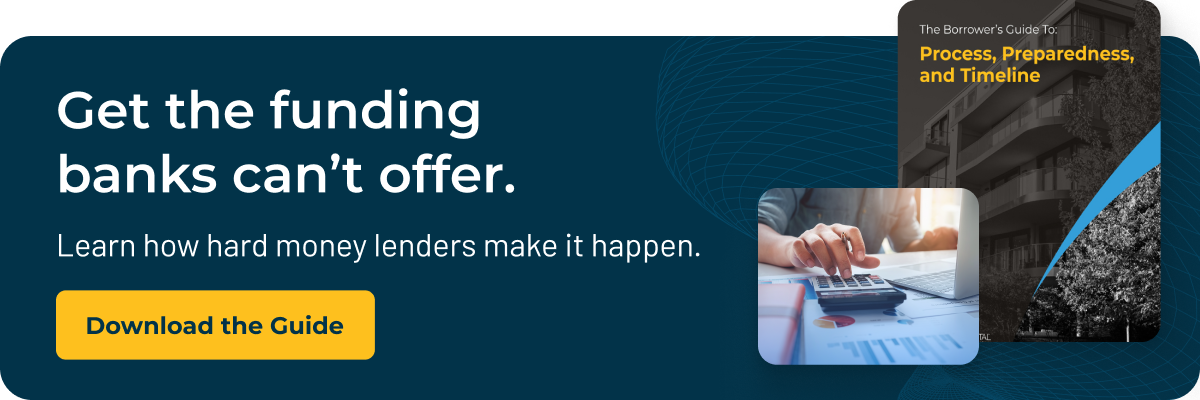Building a real estate portfolio requires cash, especially if you plan to maintain multiple rental properties or invest in commercial real estate. Unless you’re independently wealthy, chances are you need a loan to get started. Traditional bank loans are often not an option for real estate investors because of factors such as:
- Low FICO scores or bad credit history
- Cash competition in the market that requires faster closing
- Properties that don’t meet the bank’s criteria
Although a bank loan might not be possible, these factors don’t rule out getting funds from a hard money lender. With multiple types of lending options, it’s important to choose the right one for your situation.
The Gap Between Short- and Long-Term Loans
Short-term hard money loans are great for properties you intend to flip, or if you need immediate cash and know you can pay it back quickly. You just pay the interest on a monthly basis and then the principal amount when the terms expire.
However, if you plan to keep the property either as a rental or so that it has time to appreciate before you sell it (or both), you need a loan that gives you more time. If a traditional long-term loan is off the table, what do you do? A buy and hold loan can help you fill that gap so that you can get the cash you need and not feel under pressure to pay off a fix and flip loan.
How Buy and Hold Loans Help
Unlike short-term hard money loans that have terms in the range of 9 to 18 months a buy and hold loan allows you to pay the loan back with more time, often up to three years. In some cases, you might be able to get a fully amortized loan with financing terms up to 15 or 20 years, but this is not typical for hard money lenders. If the market changes and you can sell the property at a profit, pay your loan back early and keep the rest. In the meantime, generating rental income can cover your monthly payments so you can get the most from your real estate assets.
Buy and hold loans have higher interest rates and are not intended to replace traditional bank loans. Instead, they are an ideal solution to fill the gap when a short-term loan isn’t long enough and traditional bank financing is not yet an option. Many people refinance a buy and hold loan after a few years or find that they are able to pay it off before the end of the term.
When it comes to commercial real estate, buy and hold loans are great for special purpose properties such as cannabis businesses, churches, and restaurants that write off their income because these types of properties are almost impossible to finance conventionally.
Pros and Cons of Buy and Hold Loans
Like any type of lending product, it’s important to know the pros and cons of buy and hold loans before you decide to pursue one.
Pros of buy and hold loans
Hard money lenders are able to close loans much more quickly than traditional banks—often in a matter of days. Buy and hold loans also have the benefit of longer terms, which gives borrowers some breathing room to do what they need to do to improve a property without the tight time constraints of a fix and flip loan. These are perhaps the strongest reasons for choosing this type of loan, even if you do qualify for a bank loan. If you don’t qualify for a bank loan because of a foreclosure, bankruptcy, or low credit score, a buy and hold loan might still be a possibility because it’s based on your equity, not your financial history.
Buy and hold loans are a way to help you build long-term cash flow with commercial or residential rental properties when it’s not otherwise possible to get a foot in the door. Because there is no limit to the number of properties you can finance this way, you can build your real estate portfolio when the market conditions are right.
Cons of buy and hold loans
It’s important to know that you can’t get a buy and hold loan for a property you intend to occupy, including a multifamily residential building. Buy and hold loans are intended only for investment properties and not for primary residences. If you can’t get a traditional loan for a property you plan to live in, a buy and hold loan is not the solution.
Buy and hold loans also have higher interest rates than traditional loans, so it’s important to have a long-term exit strategy. This might be refinancing in a few years when you or the property qualify for traditional financing or simply paying off the loan after the property generates enough income or sells at a profit.
Secure a Buy and Hold Loan with Socotra Capital
If you’re a real estate investor or interested in becoming one, hard money loans can help you stay competitive. With fast closing rates and a range of products to match your needs, Socotra Capital is here to help you finance your real estate investment strategy. Read our Borrower’s Guide to learn more about buy and hold loans and your other hard money lending options.

